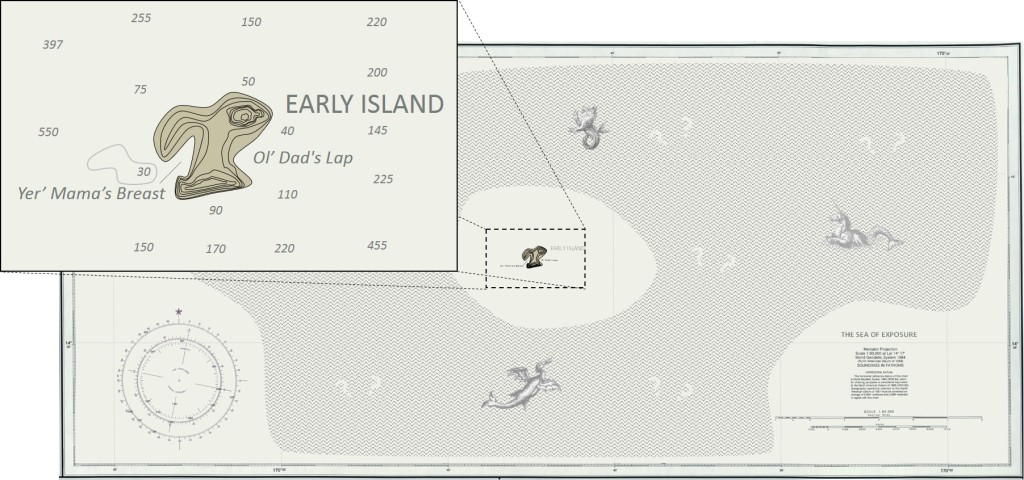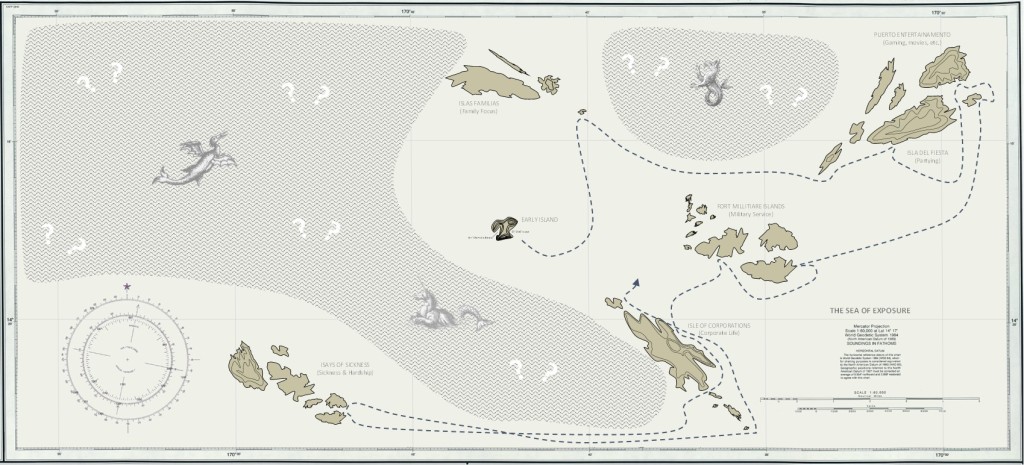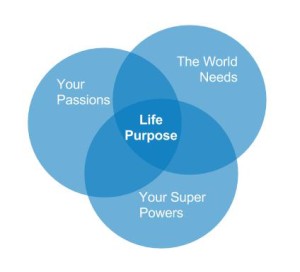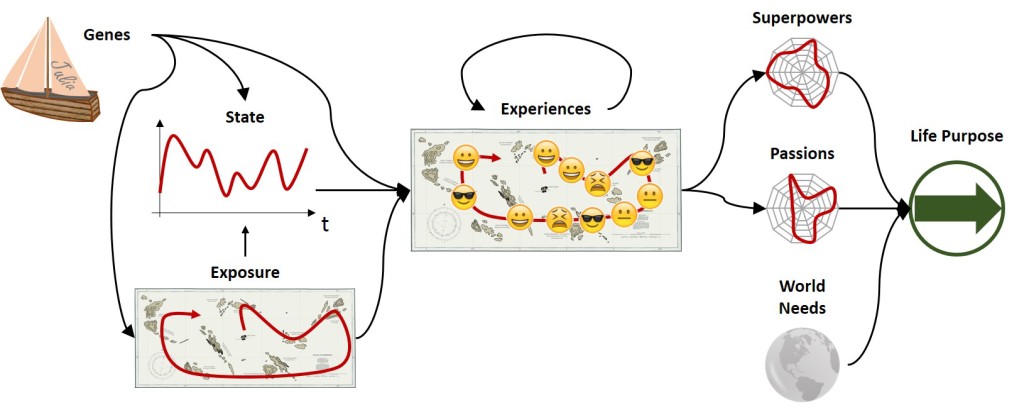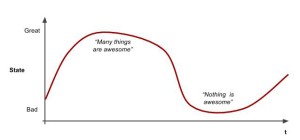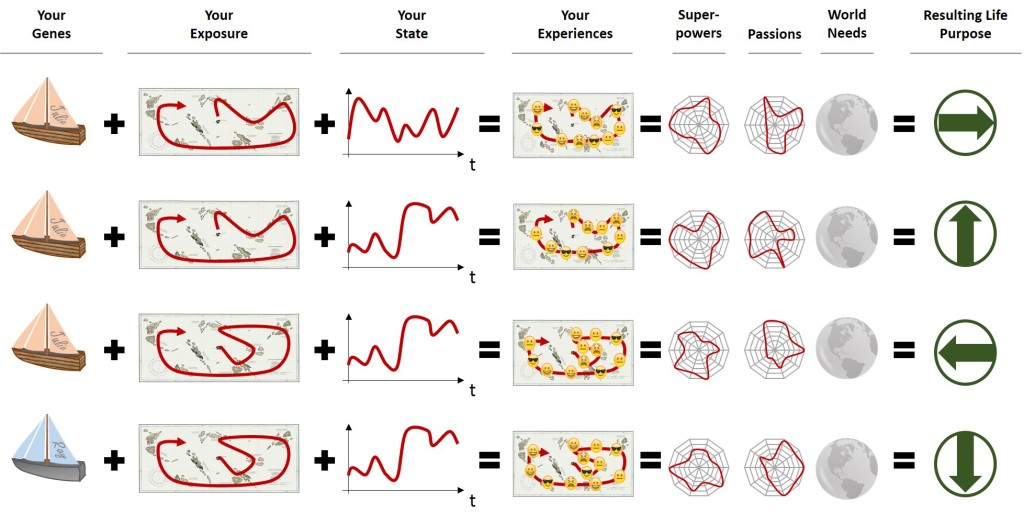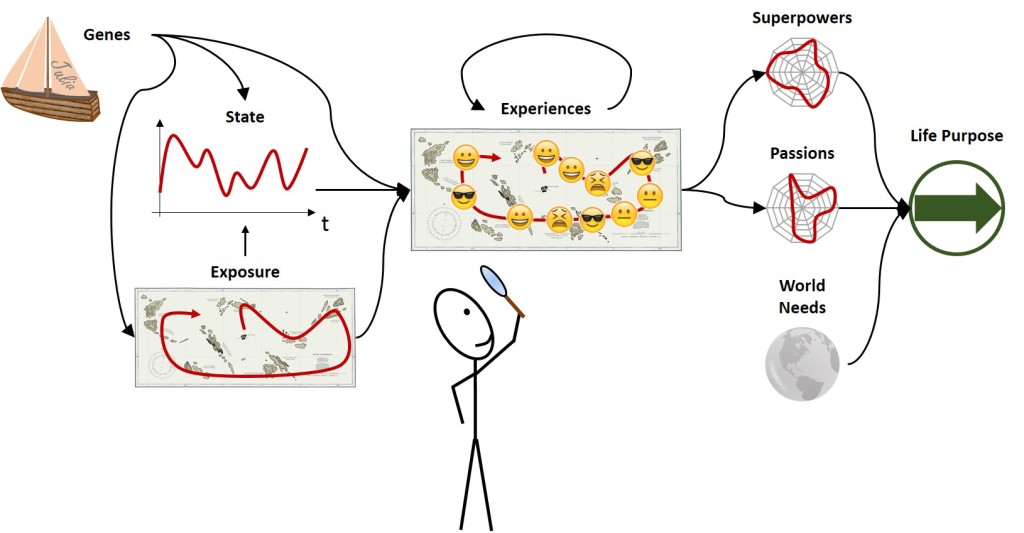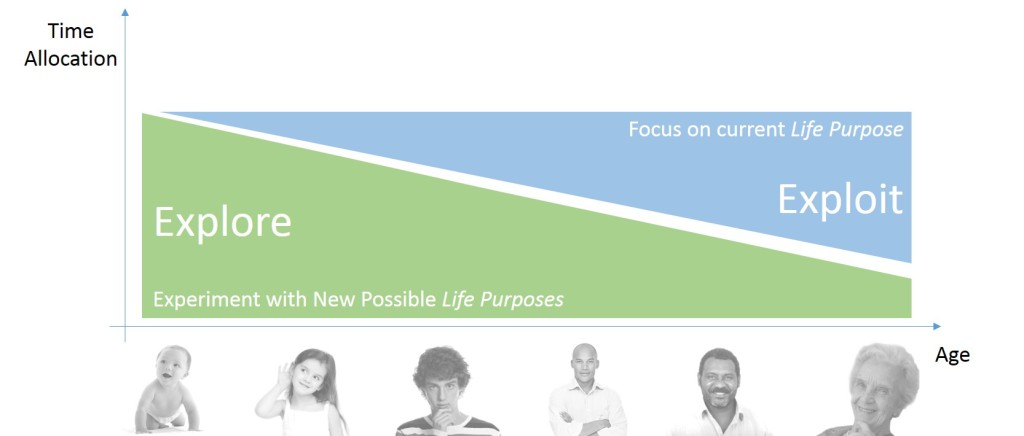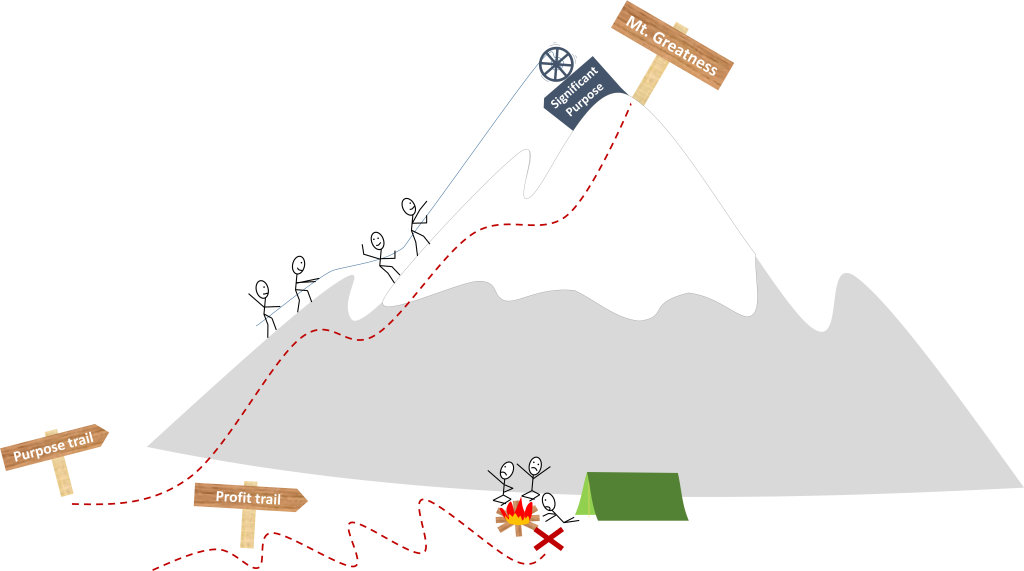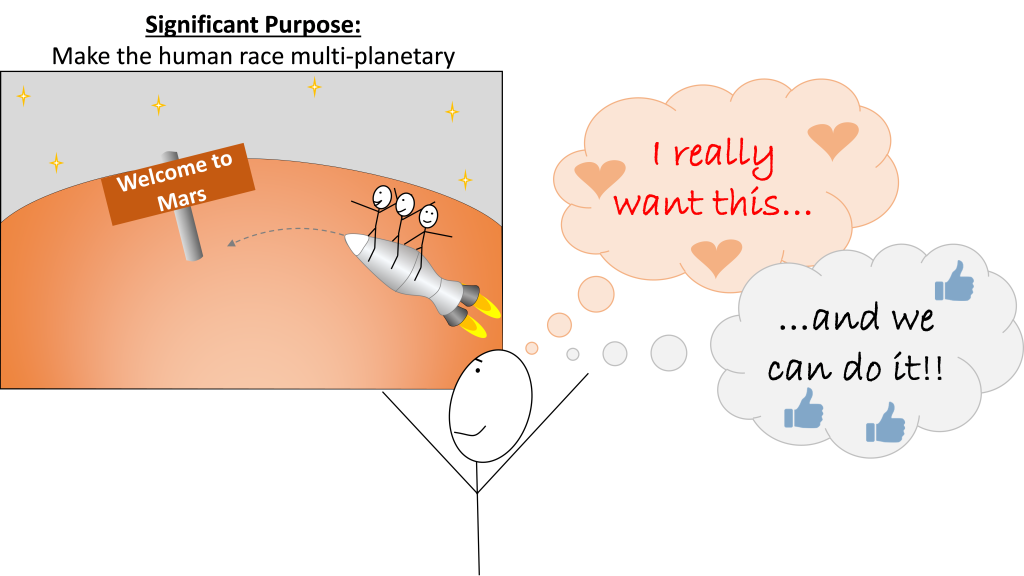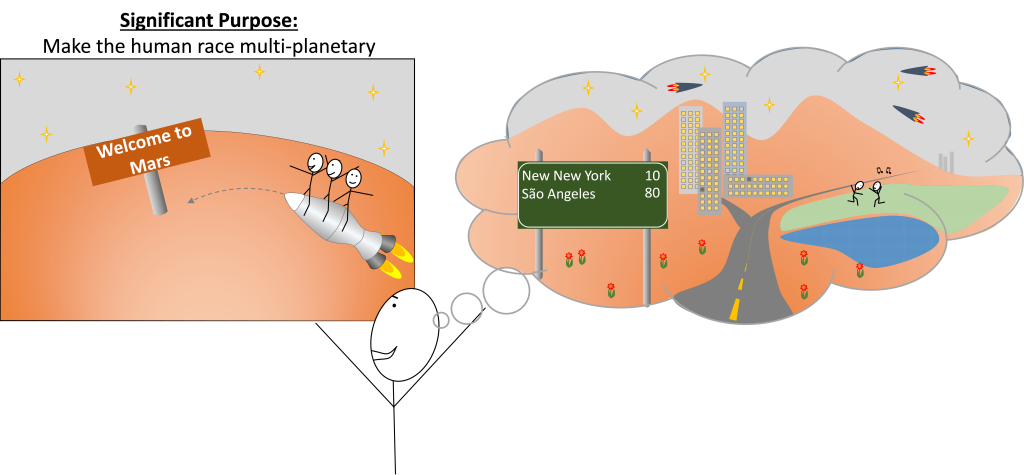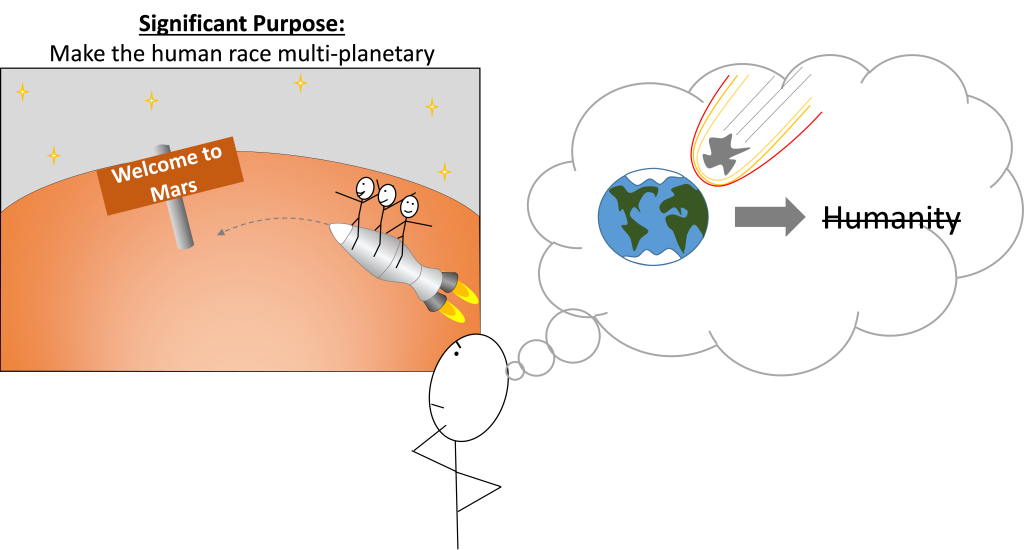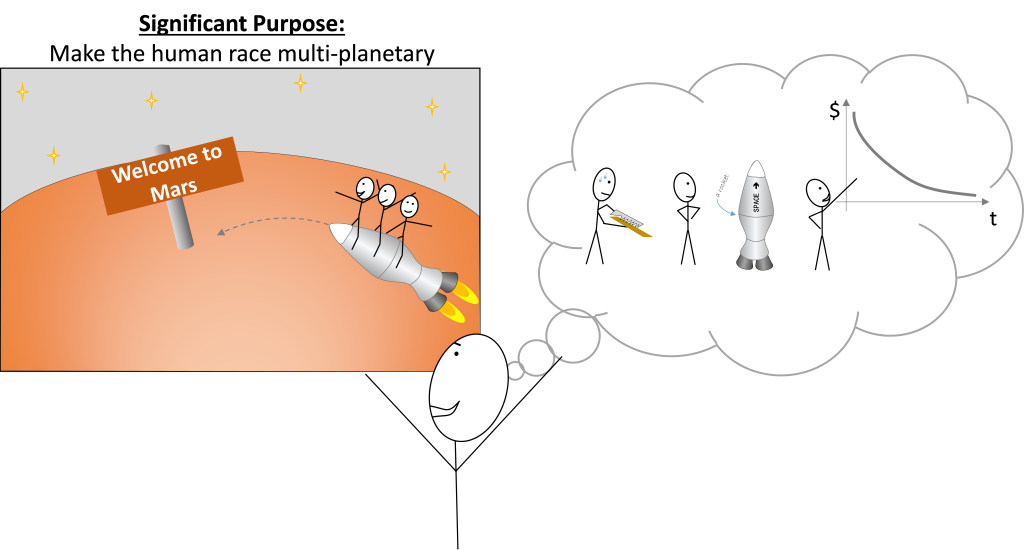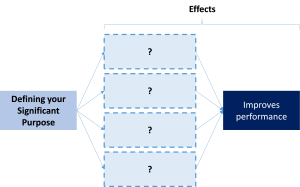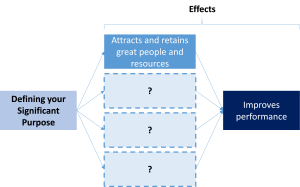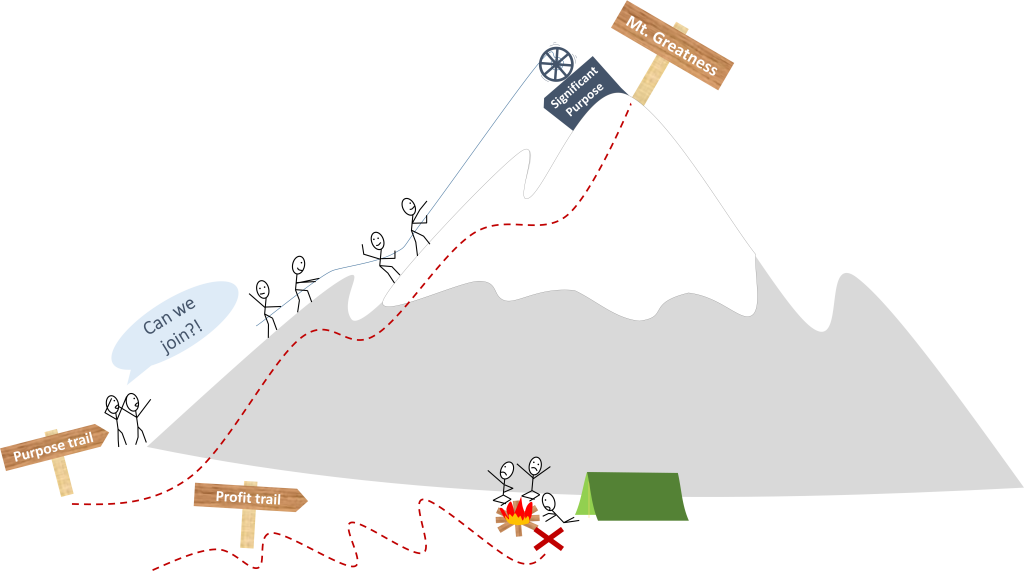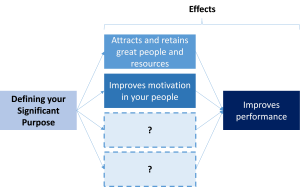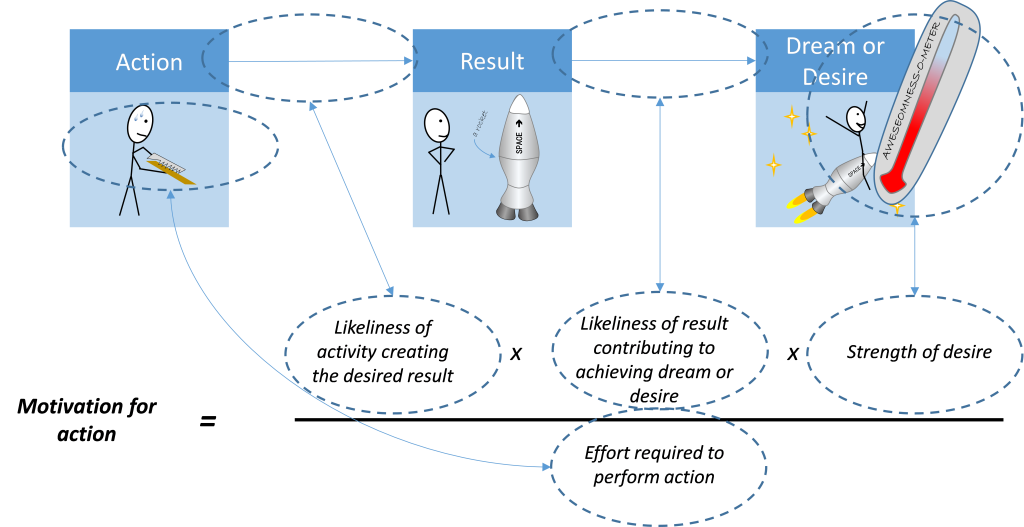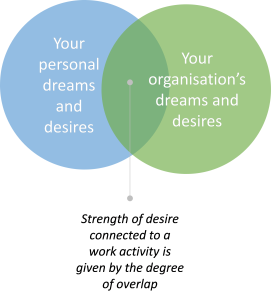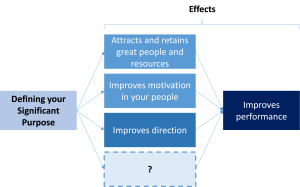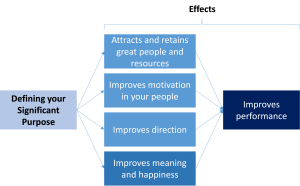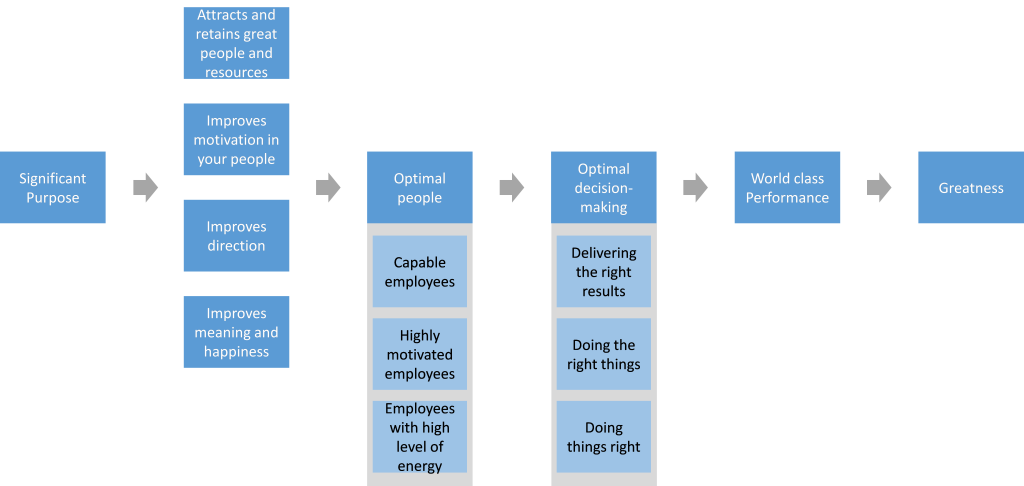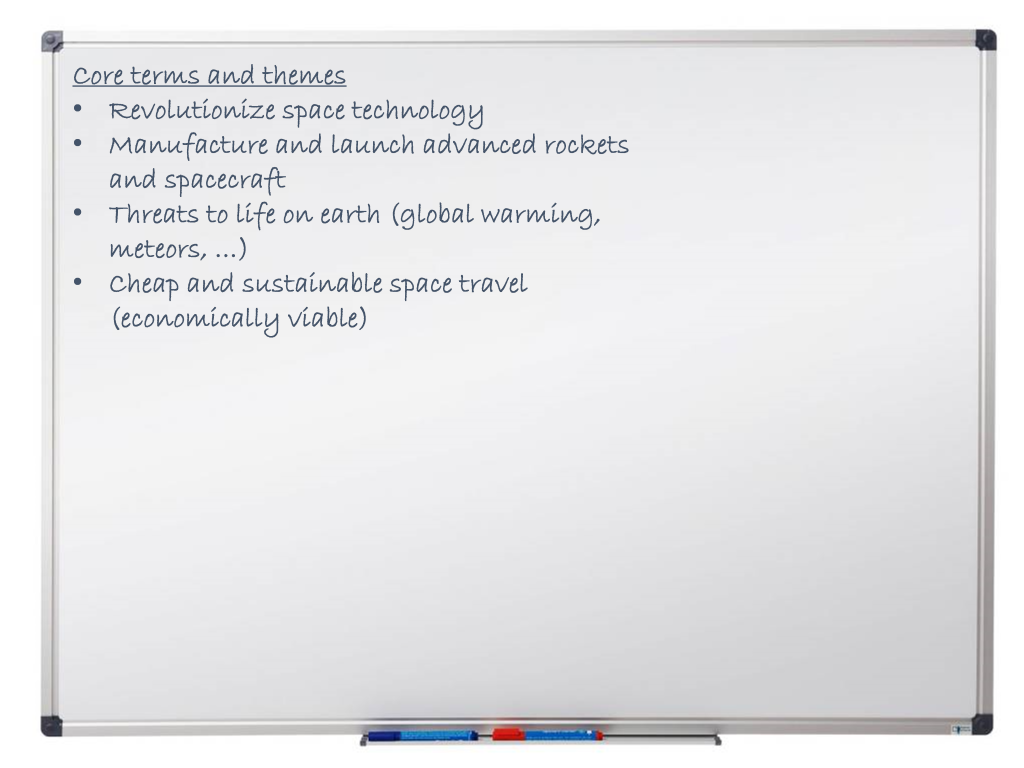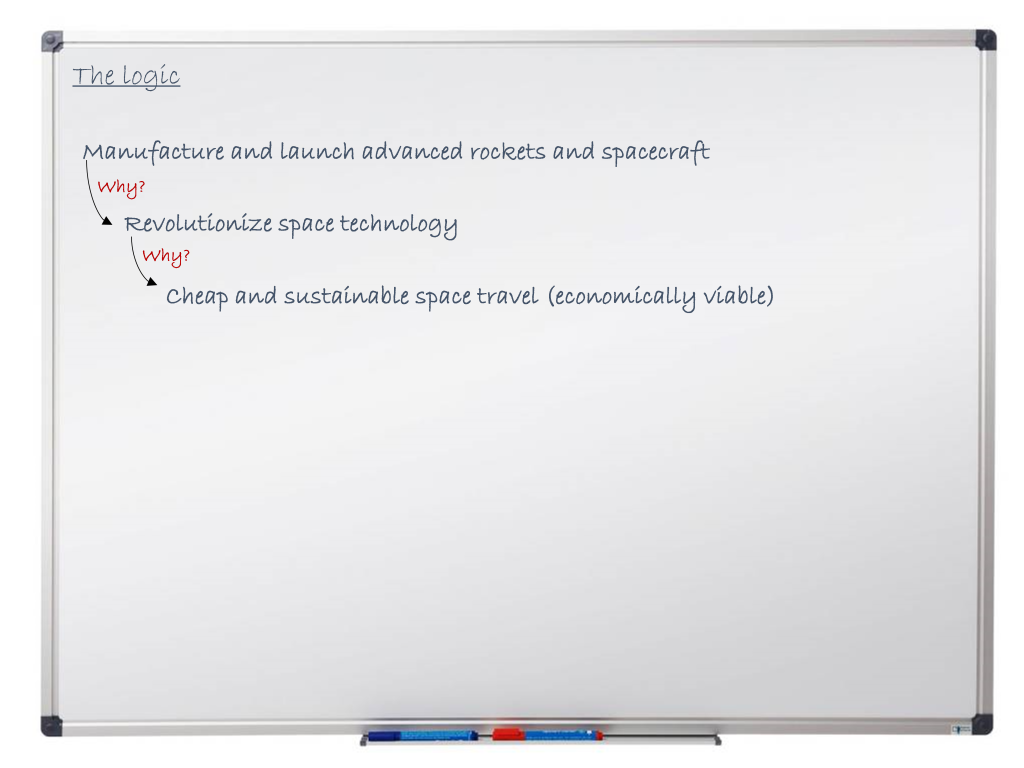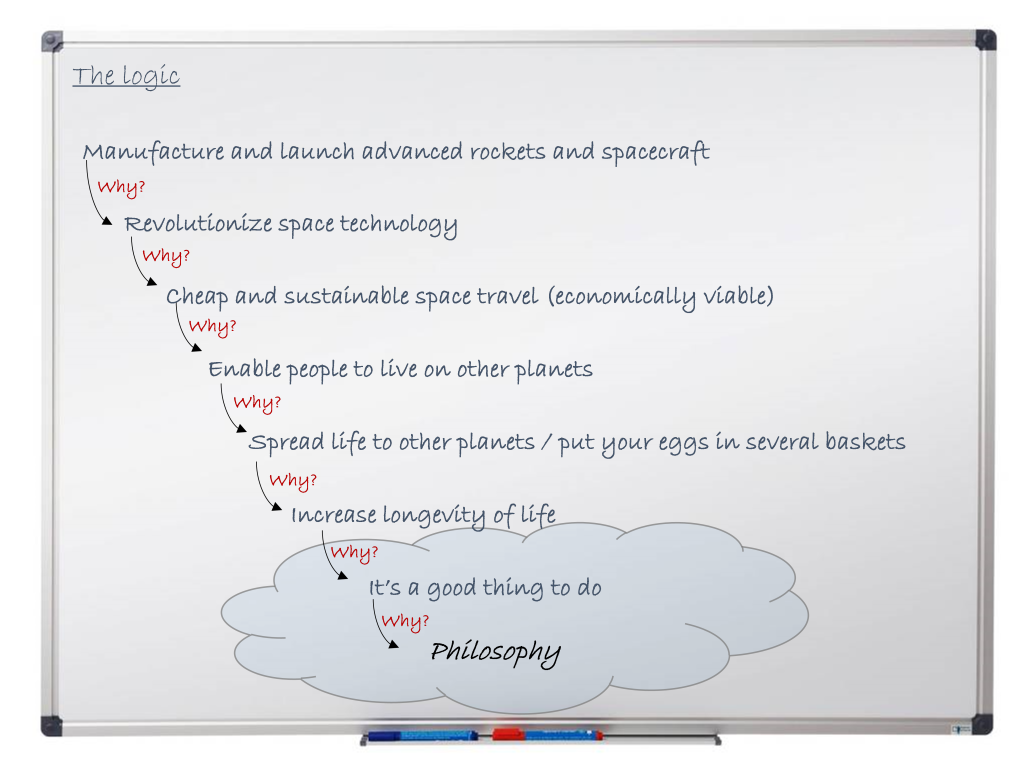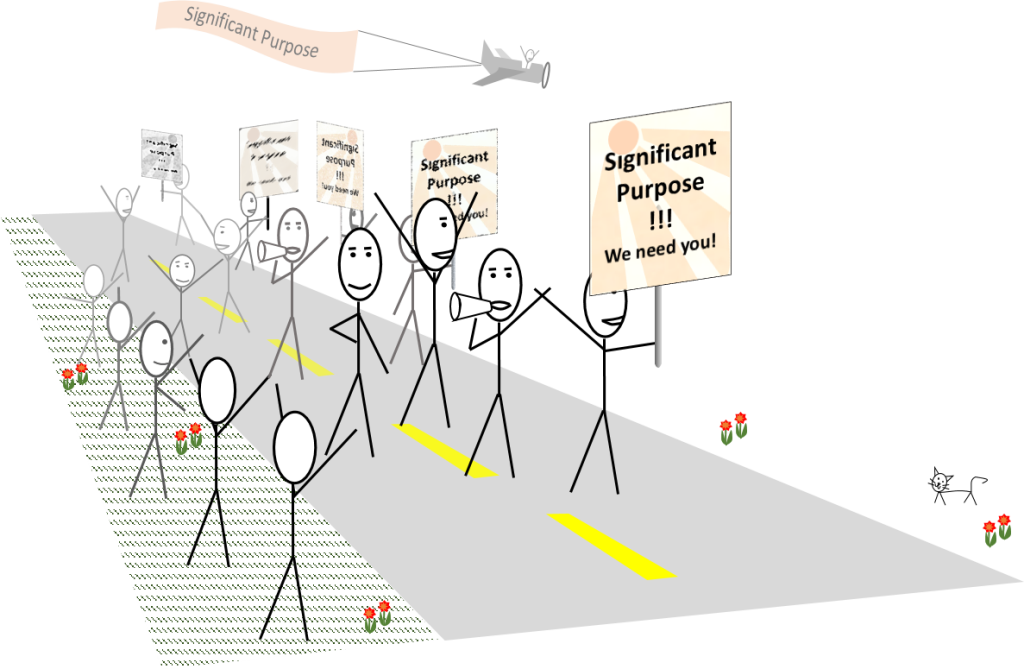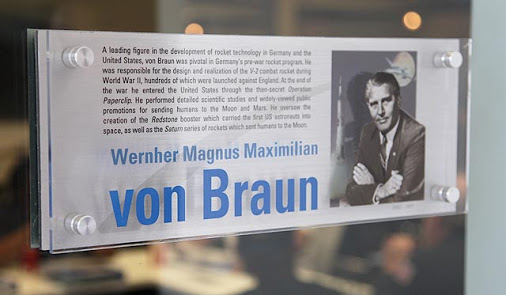Do you want to do something good for the world? Do you want to contribute to improve the human condition? This page is dedicated to make it simple for everyone to do something good. The page will be constructed piece by piece over a longer period and will ultimately contain practical and simple step-by-step guides for everything you need to know about doing good; from coming up with an idea, to creating a great business around the idea and to growing your business, along with your impact. Stay tuned!
How to Do Good – Content
- Why do something good and what is worth doing? – Blog posts to be written
- Define Your Life Purpose
- Discover an Idea – Blog post to be written
- Build a Founding Team – Blog posts to be written
- The Key Tasks of Creating a Great Organization
- Define Purpose
- The Missing Ingredient Elon Musk Discovered – Part I – What a Significant Purpose is And Why It Is Important
- The Missing Ingredient Elon Musk Discovered – Part II – How to Create a Great Significant Purpose
- The Missing Ingredient Elon Musk Discovered – Part III – How to Communicate and Live the Significant Purpose
- Define Mission – Blog posts to be written
- Build Product – Blog posts to be written
- Build Team – Blog posts to be written
- Define Purpose
The Wisdom of the Old Seadog – Part 1 – Why Define and Live Your Life Purpose
Published 14.12.2016 by Jostein Øysæd (Author)
To live a great life you need to feel good, be good to others and do good in the world. But to do good in the world you need to know exactly what your contribution should be. You need to know, what we call, your Life Purpose. This and the following post will empower you to set the course.
Once upon a time, a little sailing ship, named Julia, came into the world. It had taken the two ship builders nine long months to construct it. Thus, they felt great pride and relief in seeing that Julia could float when she was first introduced to The Sea of Exposure. One day Julia would roam this vast ocean, but in the first years of her voyage she would alternate between the safe harbours of Ol’ Dad’s Lap and Yer’ Mama’s Breast. Julia felt great sailing between those harbours. The sun was shining and Julia was blessed with a good tailwind.
As the years went by, Julia felt an increasing urge building up inside her. When studying her maritime map, she could only see a small portion of the canvas mapped out. But she had heard that the Sea of Exposure was infinitely huge, so vast that no ship had ever traveled the whole ocean. She knew she had to start explore and fill out the map.
There was only one problem. Julia didn’t quite know where to sail. She needed a navigator.
“Oh God, kill me now!”, Sir Rellington uttered to himself as he abruptly awoke to a series of heavy coughs and an intense pain in his sore and dry throat. It was already noon and he could hear the sounds of the village life going on as usual outside his shack.
The previous night had been both rough and euphoric, filled to the brim with exclusive Champagne and the finest caviar. He himself had been the center of attention, once again awarded “The Navigator of the Year”-price. All the pain from weeks of deep insecurity and distress following up to the award, instantly vanished as the winner was announced. Sir Rellington felt on top of the world, receiving standing ovation as he approached the podium.
The competition had always been fierce. There was a lot of good navigators roaming the Sea of Exposure. But nobody quite knew how to navigate as Sir Rellington. He had perfected his game over many years, playing on his client’s ego, providing the most luxurious destinations and a sense of constant action.
Julia, having heard about the award, contacted Sir Rellington and offered him a job as her Navigator for her upcoming voyage. Sir Rellington gladly accepted the position.
The next day, Julia and Sir Rellington said goodbye to the safe harbours and set sail.
Over the next following years Julia and Sir Rellington visited one after another of luxurious destinations. Sometimes the destinations made Julia feel great, providing sunshine and tailwind. On such occasions, Julia loved every second of the voyage. Everything felt easy. Other times, the sea was roaring, the headwinds gusty and the sky poured out. On such occasions, Julia struggled and could feel the wear and tear.
One day, as Julia and Sir Rellington ventured into new waters, promising great riches, they could sense a storm building up. They were soon surrounded by giant waves, strong headwinds and heavy rain. The wear and tear on the the ship was severe, and eventually a leakage appeared in the hull. In the beginning the leakage was minor, but as the terrible weather persisted, the leakage increased. Julia could sense the ship filling up with cold, salty seawater.
Fortunately, Julia and Sir Rellington was close to a harbour, and managed to get into safety before the leakage became too serious.
An old galleon watched Julia with great interest as she anchored up, and noticed the damaged hull. After Sir Rellington left the ship to grab a pint at the local Sailors Pub, the old galleon approached Julia and said: “Yarr, I see you are sailing with Sir Rellington. They say he’s a bloody good navigator, but you should be wary. He gives you wind in the sail, indeed, but seldom takes you where you need to go. You will get a lot of hard sailing following his course. You are better off minding the weather first!”. Julia, slightly amused, scoffed it off, thinking that the old seadog was full of gibberish. Sir Rellington was known for being the best of the best, she thought. Not only that, finding a new navigator would require time and effort. Julia quickly forgot the encounter.
After casting off the next day and setting sail, Julia and Sir Rellington was again met by harsh sailing conditions. The sea was in uproar and giant waves hauled water over them. Again Julia noticed the seawater pouring into her ship. Concerned, Julia summoned Sir Rellington to weigh their options. A bleak Sir Rellington emerged from his room and urged her to stay the course. “We need to push on through the storm. Eventually we will hit better conditions. It’s too late to rethink the course now!”. Julia, trusting her navigator, stayed the course.
The second day the conditions went from bad to worse. It started raining cats and dogs. The damage on the hull increased, as did the leakage. Now half the hull was submerged in water. Julia, feeling despair, summoned Sir Rellington. Sir Rellington, looking weak and sporting a greenish colour in his face, persisted on his advice to stay the course. “There is no time to rethink. We must continue!” he yelled through the storm. Julia reluctantly agreed and pushed on.
The third day the weather went from worse to ugly. The wind was gaining momentum and tearing heavily on the sails. Now three quarters of the hull was submerged in cold seawater, and Julia was barely able to stay afloat. “We better find calmer waters soon or we will be sleeping with the fishes”, Julia thought to herself. Suddenly the words of the old seadog came back to her. “Mind the weather first!”. Again Julia summoned Sir Rellington. But this time, as Sir Rellington emerged from his cabin, Julia turned the ship sharply, surprising Sir Rellington and making him stumble overboard. The weakened Sir Rellington quickly succumbed to the roaring sea.
The water was still pouring in through the leaking hull. Julia figured out she was less than an hour away from sinking. Having decided to listen to the words of the old seadog, Julia decided to take down the sails for a while to contemplate her predicament. “Mind the weather first?”. When was the last time she felt the warmth of the sun and the delightful breeze of a tail wind? She could barely remember. As she was reflecting on the situation, the intensity of the storm decreased slightly and Julia could sense a few tiny rays of sunlight barely making it through the thick clouds. The sensation of sunrays hitting her hull immediately brought back memories of pleasant sailing. Julia plotted a new course and set sail.
Being on a new course, the weather improved. The rain ceased and the sea calmed down, giving Julia some time to pump water out of the hull and fix the leakage. Eventually, Julia could sense her hull bathing in warm sun rays, drying up the wood. As she approached her new destination, the headwind turned into tailwind. Julia felt better than she had felt in years. “Never again will I hire a navigator failing to provide good sailing conditions, regardless of how fancy the destinations”, she thought to herself. Julia had learned the first principle of maritime navigation: “Mind the weather first”.
——–
The moral of the story? If you subjugate yourself to what others and the society think are great experiences, but not you, you end up with hardship. You’ll face strong headwinds and large waves, tearing up your ship. Following a string of such experiences can lead to depression. You feel living is pointless, life giving you no enjoyment and that there is nothing you can do about it.
On the other hand, if you mostly chase experiences that you think are great, that is, experiences giving you an abundance of energy, motivation and other good feelings, everything in life suddenly feels easy. You wake up every morning feeling super excited to begin the day. The sun is shining and life is awesome!
The ability to “mind the weather”, to be aware of what kind of experiences are great for you, enables you to get rid of navigators such as Sir Rellington and to be your own navigator in life.
But after having tossed Sir Rellington off the ship, you are now on your own. It’s is up to you to try to predict what next experience, among the countless possibilities, will give you great enjoyment. Since this is not an easy decision to make, you may be wondering how you can make this decision easier for you? How can you massively improve the number of times you make a correct decision?
This is where your Life Purpose enters the picture.
What is a Life Purpose?
There is a question that scientist avoid, that philosophers and psychologist love, that parents dread and that all humans need an answer to. It is the “Why”-question; the questions of spirituality; the question aiming to place yourself in a larger picture.
Scientists will tell you that when you ask “why does the moon revolve around the earth?”, what you really mean is “how does the moon revolve around the earth”. The moon doesn’t have an intent, it just follows a set of physical laws. A human being, on the other hand, has an intent and thus need to have an answer on the “Why”-question, mainly to make sense of his or her existence (b.t.w. a good crash course in Existentialism can be found here) . Why was I born? Why do my life matter? Why do I do what I do? In essence, your Life Purpose is the answer to those questions. Your Life Purpose is the target for your life. It is what you were born to contribute to the world and the reason behind all your daily decisions and actions.
By defining your Life Purpose you make it easier to navigate accordingly. When you navigate according to your Life Purpose, you, per definition, spend your time on activities that you deem as highly important and inspiring. As a result, a massive amount of motivation, energy and other good feelings are released (exactly how a purpose impacts your motivation is described in more details in this blog post, discussing the effects of an organisation’s Significant Purpose on employees).
Hence, defining and living your Life Purpose enables you to live a life full of sunshine and tailwind and to improve the world around you in the process. That sounds pretty good, right? But where exactly should this Life Purpose come from? Should it come from some external divine power, delivered to you through some ancient text book? Not necessarily. As you will see in the next part, we suggest you take a deep look in the mirror.
Read on or go back to top.
The Wisdom of the Old Seadog – Part 2 – How to Define and Live Your Life Purpose
Published 17.12.2016 by Jostein Øysæd (Author)

The ultimate gift from the creator (yourself) is to give the creation (you) a Life Purpose and means to pursue it.
In Part 1 of this post we saw that a good way to live a great life is to define and live your Life Purpose. We also saw how crucial it is to be self-aware and to reflect to be a good navigator in life. In this part we will put it all together to provide you with a practical step-by-step guide for defining and living your Life Purpose. But, as with any new tool to master, before you can deeply understand the practical guide, you first need to get a feel for how the tool works and what the involved forces are.
What Shapes Your Life Purpose?
Every human being is different. Regardless of background and life so far, every person have developed a set of interests and skills that make him or her unique. We like to think about this uniqueness as our passions and superpowers.
Let us look at some examples:
- Were you born into a poor family with alcoholic parents, not able to take care of you and your siblings? Did you experience a lot of pain in your childhood? If this was the case, you may, from an early age, have learnt how to take care of your family and how to make everyone around you feel good about themselves, despite a dire situation. You may also have gotten a deep passion for helping others to avoid the kind of pain you had to endure in your childhood. At least this is what happened to Tony Robbins, the world’s best known life coach. For those of you who know Tony Robbins, it’s obviously that he has some strong superpowers and passions.
- Did you experience a fatal traffic accident rendering you paralyzed from your waist down and thus sentencing you to a life in a wheelchair? If this was the case, from the moment of accident you were forced to spend more time than others using your other bodyparts, for example your hands or your brain. While others were running in the forest, you were sitting inside learning, thinking or making something with your hands. As a result, you without doubt developed some unique superpowers and passions.
Granted, these are extreme examples. But passions and superpowers are formed in similar ways in everyone and constitutes the two first factors shaping your Life Purpose.
Of these two factors, passions is the most important factor. Your passions will drive your efforts and keep you going until you have solved the problem at hand. Additionally, with enough passion for a topic, it will be easy for you to acquire any new superpowers that are required.
Your superpowers will enable you to solve certain problems with less effort than others. Hence it will make sense why you in particular are working on a given set of problems.
The third and final factor shaping your Life Purpose is the world needs. If your life doesn’t positively impacts one or more people, other than yourself, your life doesn’t matter. You might as well not exist. The more people you matter for, the more you matter. Hence, your Life Purpose must in some way address a real and significant need in the world.
To summarize, your life purpose is to help satisfy the most important world need that best utilizes your passions and your superpowers.
That means, to define your Life Purpose you need to know your passions, your superpowers and what the world needs.
To learn what the world needs is the simplest task. The only thing you need to do is to start paying attention, being curious and asking questions about what is happening in the world. For instance, start following quality news sites.
But learning about your passions and superpowers can be more elusive. This information isn’t neatly structured and summarized into a paper, delivered on your doorstep every morning. To be able to identify your passions and superpowers, you first need to understand how they are formed.
Your passions and superpowers are gradually formed and evolved throughout your life. They are mainly shaped by the different experiences you have in your life. Your experiences are again shaped by what you expose yourself for, your emotional and physical state during exposure and your genes.
Let us take a look at each of the four factors, in reverse order.
Your Genes
Depending on your genes you will be naturally good at some things and bad at other things. In the story about Julia and the old seadog, the genes are represented by the form of the ship.
Some ship types are better suited for some particular tasks than others. For instance, an icebreaker is a better choice if you want to travel through the ice-covered arctic sea during winter time, compared to a canoe. But a canoe is the better choice when traveling down a shallow stream in Alaska.
Genes impacts every aspect of forming superpowers and passions, from what exposure you seek, your state during exposure and how well your natural skills enable you to handle that particular exposure.
Your State
Your state is short for your physical and emotional state. Are you feeling excited, energetic and happy or stressed, fearful, lazy and irritable? In our story, the state is depicted as the weather (emotional state) and the physical conditions of the ship (physical state). If you are in a shitty state (bad weather and/or the ship is falling apart), nothing is exciting and interesting. But if you are in a great state (the sun is shining and the ship is in tip top shape), almost everything can be exciting and interesting.
Your Exposure
Your life is a string of exposure. The exposure being the different situations you seek throughout your life, the external stimuli. In the story about Julia, exposure is depicted as the different areas of the vast sea. Different routes through the Sea of Exposure, represents different lives lived, or different sequences of exposures. For instance, if you started working for your family’s company at an early age, while your friends were playing together in the forest, you and your friends would end up with different travel routes, as depicted in the images below.
Your Experiences
For every exposure you have a subjective experience. Some experiences you enjoy, other experiences you dislike.
Whether or not you enjoy an exposure is dependent on factors such as:
- You get positive feedback from others during the exposure. E.g. you spend hours on drawing, and when you present the drawing to your parents they are highly impressed by your masterpiece and tells you that you could be the next Rembrandt.
- You handle the exposure better than most people thanks to your genes. For instance, you may have an extra large hearth with increased oxygen distribution capabilities, enabling you to run 400 meter much faster than your classmates.
- You are in a generally good state during the exposure. E.g. Thanks to lots of sleep, a nutritious breakfast and the low stress environment of the cabin, surrounded by flowers and singing birds, you find the book you read more interesting than before.
Having had an enjoyable experience, you often seek back to similar experiences. Frequently returning back to similar experiences increases your ability to handle the situation and enable you to absorb more information from the exposure. As a result, you enjoy the experience even more. This is a loop of positive reinforcement.
Your superpowers are formed through the frequent exposure and following adaption to some type of stimuli. The typical example is how the biceps becomes larger the more often you frequent the gym (exposure to resistance, adaption through increased quantity and quality of muscle fibre).
Similarly, your passion for a topic is fertilized by the new patterns and questions continuous unraveling as you spend time on a topic of interest. As you get a deeper understanding of the topic, you begin appreciating its complexity and finer details, motivating you to spend more time on the topic.
To summarize, together, exposure, state and genes shapes your experiences. Experiences again shapes your superpowers and passions. Finally, your superpowers, passions and the world needs shapes your Life Purpose. Different configurations of these factors yields different Life Purposes, as summarized in the figure below.
Now that you know what shapes your Life Purpose and how all these factors interact to create different Life Purposes for everyone, let’s move on. Let’s see how you can use what you have learned to define and live your Life Purpose.
A Step-By-Step Guide to Defining and Living Your Life Purpose
We have already learned that to define your Life Purpose, you need to identify your superpowers and passions. Since your superpowers and passions are shaped by the sequence and quality of your experiences, all required information can be found be analyzing your previous experiences.
This is exactly what the old seadog alluded to: “Mind the weather first”. Minding the weather first means being conscious about your experiences, asking questions such as: “In what experiences have I felt a deep sense of enjoyment?” “What was the source of that strong feeling?” How you experience different situations functions as bright lighthouses guiding your search for your superpowers and passions. As a consequence, our suggested process for defining and living your Life Purpose will involve the use of self-awareness and reflection. Self-awareness being crucial for understanding what you feel and sense in any situation, while reflection being required for understanding what these feelings and sensations means.
Experimentation is the third powerful tool utilized in our process. Why? Because you can’t really know what you like, what you are passionate about and what you are good at before you have tried it. Experimentation is all about seeking new exposure, be aware of how it feels and finally reflect what that means. It’s about sailing to new waters, mind the weather and understand what is causing the weather.
Putting these tools together, we end up with a practical step-by-step process looking like this:
Let us walk you through each of the steps.
1. Get in State
We have already talked about the importance of being in a good state, but it’s too important not to repeat. There is no need to experiment with possible Life Purposes if you are in a very bad state. The outcome is already known. You will not enjoy the experiment. That is why the first step of the method is to ensure you are in a good state.
Getting into a good state is mainly about long term habits, such as eating healthy food, sleeping well, exercise right, have healthy thoughts and avoid negative stress. See this page for more details on how to do this.
But there are also a few simple tricks you can use to improve your state immediately:
- Move. Motion impacts emotion, as Tony Robbins likes to say. So get your ass up from the couch and spend the next minutes doing some movements, either some exercises or some stretching.
- Breathe. Are you stressed? Perform a few deep stomach breaths and feel the brain quiet down.
- Visualize. In your mind, go back to an enjoyable experience from your memory and bring back those feelings and sensations. What do you see? What do you hear? What do you taste and smell? What do you feel?
- Meditate. Quiet your brain by focusing on your breaths for a few minutes. Pay attention to your sensations and feelings.
- Listen to energizing music. What type of music gets your heart pumping? Put it on high volume for the next few minutes.
- Laugh. It’s hard to be in a bad state when you are laughing out loud. Find your favourite funny YouTube-clip and make yourself laugh.
These are just some examples of measures you can take to get into a better state. Choose whatever floats your boat. The important thing to remember is that you are in full control of your state. So from now on, never accept being in a bad state.
As soon as you are in a good state, you can move on to the next step.
2. Identify Possible Purposes
The second step is to find several possible Life Purposes. The reason we identify several possible Life Purposes is because we don’t want to exclude too many options before we have done some experimentation in the third and final step. Remember, it’s hard to know what you enjoy before you have tried it.
We suggest you identify possible Life Purposes in the three following steps:
- Identify passions and world needs
- Identify superpowers
- Investigate
Let us take a look at each of the steps.
2.1 Identify passions and world needs

Find a pen and some paper and write down keyword-based answers to the following questions:
1. What are you already spending your time on these days?
E.g. what activities have you spent time on the last week or last month? Which of these activities do you enjoy the most? Why?
If you are passionate about something, the chances are that you’re already spending some time on this passion, and loving it. Maybe you’re just not conscious about the fact that you could elevate this passion to your Life Purpose.
2. What topics can you talk about all day without getting tired?
This question is similar to the first question, just relaxing the requirement of “doing”. Some passions are easier to talk about, rather than doing something with. But maybe there is potential to elevate a topic you like to talk about to a challenge you will spend your life working on?
3. What are you curious about?
Right now, brainstorm 10-20 things you would like to read a book about if you had a spare weekend. Looking over your list, do you see any overlapping and related topics?
As Steven Kotler writes in his great article about finding your Passion, where several topics of curiosity intersects, passion can be found. Kotler attributes this phenomena to the fact that we love detecting new patterns. When topics of curiosity intersects, the mind detects a cascade of new patterns, generating a lot of energy in the process.
The three first questions are quite easy to think about. The following questions need some more reflection and prioritization. First, lets bring in the world needs.
4. What world needs would you solve?
If you had to dedicate your life to solve only a few world issues or make only a few world opportunities a reality, which would it be? Why?
We have compiled an incomplete list of possible opportunities and issues to help you think about this question. But feel free to include your own thoughts about what the world needs are.
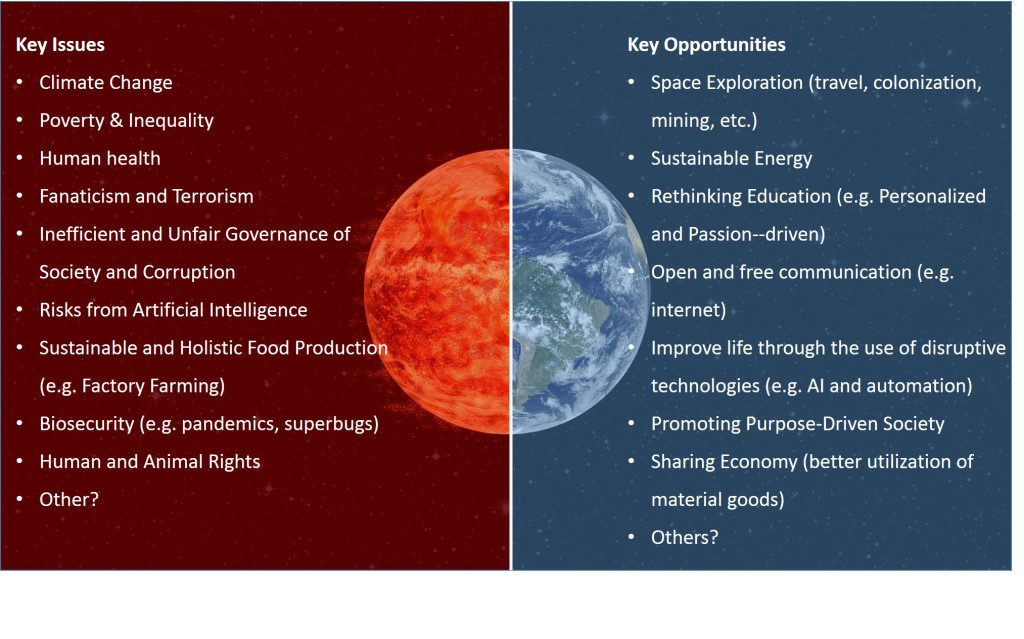
Of course, every human being would like to live in a perfect world where all of the above key issues are solved and all key opportunities are realized. But try to limit yourself to only a few of the topics. Identify the topics you are most passionate about.
5. What would you spend your time on if you had all the money in the world? Why?
One possible reason why you are not already spending your time on what you are most passionate about, may be due to something called “reality”. You live in it. You need to make some money to own a table and to put food on it, and you may not yet know how to do that solely through your passions. But, just for a few minutes, you can temporarily relax the earning requirements, just to make sure we are not throwing away too many possible Life Purposes too early in the process. Don’t you worry, we will get back to reality soon; in step 2.3, to be specific.
The final and sixth passion-question is similar to the previous question, in that, for most people, it relaxes the earning requirement. But it adds a new requirement. And this requirement will feel a bit uncomfortable. Question number six exaggerates the finity of your own and everyone’s life and forces you to experience an extreme time constraint. For some people, this exaggerated time constraint may induce a feeling of helplessness and the feeling that everything is pointless. That is completely normal, but try to avoid that way of thinking for a moment. Approach the question with utterly acceptance of your situation and with a strong focus on solutions.
6. With one year left, what would you focus on?
If you suddenly got the message that you only have one year left to live and there is nothing you can do about it, what would you make sure to spend you time on to make sure you have contributed something to the world? Why?
This question has a focusing effect. It separates what is highly important for you from what is just important. It forces you to prioritize and choose among possible legacies.
Hopefully you have written down some keywords representing possible passions by now. Let’s save them for later and move on to understanding your superpowers.
2.2 Identify superpowers

Keep your pen in your hand and continue writing down answers on the piece of paper you used in the previous step:
1. What is easy for you?
What activities seems to be easier for you to handle compared to others? What kind of problems and challenges are you especially good at solving? What does this mean? What skills do you excel in?
Try to recollect situations and activities from your entire life. When did you feel that something was easier for you than for others? Maybe these situations means you have some special superpowers? Don’t be shy. Don’t be afraid to brag about yourselves while thinking about this question. It’s better to identify too many superpowers than too few.
2. In what situations do you feel a sense of flow?
What are you doing in these situations? What do you enjoy with these activities? What skills are relevant in these activities?
The state of “flow” is commonly described as being completely submerged in an activity, losing track of time. If you get into a state of “flow” you are doing an activity you highly enjoy, an activity you sufficiently master and an activity you are highly motivated for doing. In other words, if you get into the state of flow when doing an activity there is a high probability that you have some superpowers related to that activity.
3. What has been your hobbies throughout your life?
What types of activities have you really enjoyed doing? What was it with the activities that made you enjoy them? What skills was relevant?
If you are lucky, you are already spending some time on activities that you love, for instance through your hobbies. If you spend a significant amount of time on doing a given activity, you build superpowers. This questions i all about identifying the superpowers you have acquired through your hobbies.
Hopefully you have been able to jot down some keywords related to superpowers. Remember, everybody have spent their time somewhat different, thus everyone have ended up with some distinct set of superpowers. How have you spent your time different than others? What superpowers are a consequence of that time spent different?
If you haven’t been able to find any superpowers, don’t worry too much. Remember, if you have strong passions, you will be able to acquire the required superpowers over time.
Let’s move on to the next step, were you will investigate the answers you have written down in the previous two steps.
2.3 Investigate answers
Resulting from the last two steps you now have a piece of paper with some possible passions and superpowers written down. Hiding within these keywords lay possible Life Purposes. This step is all about mining your list. You will refine, reflect on and prioritize the items in the list. Let’s get started!
1. First, tidy up the list.
- Group similar and related passions. If you have many possible passions on your list create “umbrella passions” to make the list more orderly and simple to work with
- Order the resulting list according to level of passion, from highly passionate and so on
2. Begin on top of your list of passions. For each passion, brainstorm the following questions:
- What are the 2-3 biggest challenges and desired changes related to this passion?
- How can you use your superpowers to help solve these challenges or makes these changes happen? Think high level. Do not go into details at this point. Save details for the experimentation step
- How can you create value for other people by solving these challenges? It is enough to think there is a slim chance that you can create value. You don’t need to know exactly how. Again, such details will be addressed in the experimentation step.
3. Re-order the passions according to 1) intensity of passion, 2) fit with your superpowers and 3) fit with world needs.
After walking through these steps you are now looking at list with possible Life Purposes, prioritized by level of passion and so on. As mentioned, there is no guarantee that you will feel super passionate every day if you immediately quit your dayjob to start working on the topic on the top of your list. That’s why we suggest you start slowly. We suggest you experiment with your possible Life Purposes. Only through spending time on the topics, will you be able to sense if you enjoy the topic or not.
3. Experiment
Choose the first item on your list and commit to doing the following three things every day (approximately 15 min) for two weeks:
Morning Routine (5 min)
- Sit down, relax and take a few deep stomach breaths
- Visualize how the world would be if you already have solved the challenges you are aiming to solve. How would you feel in this future world? How would the people that are impacted by your work feel?
- Commit to spending at least 5 minutes on working on the selected topic. Decide what you will work on today, for instance: clarify goal, do some research, talk with friends about the topic, explore related ideas, think about how you can create value for people related to this topic, etc. Be concrete on exactly what you will do and when you will do it.
Work Session (>= 5 min)
At the decided time, do the work you have committed to do today. As you work, be aware of how it feels to work with the topic.
Evening Routine (5 min)
Reflect on the following questions:
- How passionate do you feel about the topic you are focusing on? (1-10, 10 is super stoked)
- How easy is it to prioritize time to work on the topic? (1-10, 10 is super easy)
- How does it feel during and after you have worked on the topic? (1-10, 10 means it feels great)
If your total score is below 18, think about what you can do to improve the score
Experiment with a topic at least for two weeks. Remember, it is only five minutes of work every day. If the total score never gets above 18, try out the next topic on your list.
When you find a topic that gives you a sustainable total score of 24 or above, you have found a very promising candidate for your Life Purpose. Your choice is then, should you keep on experimenting with other possible Life Purposes, challenging the current leader, or stick to the Life Purpose already identified?
We believe it is always a good thing to keep exploring and exposing yourselves to new topics. You never know what you will massively enjoy. The possible upside is great. In other words, you should always allocate some time for exploration. But, exploring also takes time, time you need to spend on exploiting the Life Purpose you have already identified. The older you get, the less time you have left to work on your Life Purpose. Hence, in the same way you shift your pension savings from more risky assets to more secure assets as you get older, shift your time allocation towards working on your already defined Life Purpose versus spending your time on exploring possible new ones.
As you spend more and more time on your Life Purpose, feel free to continue with the proposed morning routine. Just increase the amount of time you spend on your Life Purpose every day, eventually spending at least eight hours a day. To live your Life Purpose means spending a significant amount of time on it.
By following our suggested process, hopefully you have identified one or more topics that ticks you (if you haven’t, keep experimenting with new topics and expose yourself to new experiences, then repeat the process). As you spend time experimenting and thinking about your Life Purpose, every aspect of your Life Purpose will get clearer and clearer. As your Life Purpose gets clearer and clearer, your passion for your Life Purpose will increase. After a while you will see no other option than just starting working full time on your Life Purpose. Will you start a new company or will you join an existing company related to your Life Purpose? How will the world look after a few years with your highly focused efforts? Only time will tell.
In any case, we are very excited about what you will accomplish. So please keep us in the loop about your progress and accomplishments on your road to achieving your Life Purpose.
Afterthought – Life Purpose in a Larger Context
This blogpost was written in the fall of 2016, a time highly characterized by the uproar of the faltering “middle class” in the western world, evidenced by Brexit and the newly elected president Trump. With a peaking earning power during the 1970, the manual worker in the west has gradually gotten it worse, thanks to globalization and automation.
This impoverization of the working class will only continue to accelerate. In effect, we no longer need humans to produce the physical goods and services we need. Naturally, this will lead to the two following issues:
- Widening of the inequality gap. The 0,1 % owning the robots will get richer and the workers will get even poorer. Stephen Hawking wrote a good article about this just recently.
- Idle hands. In a transition phase, before massive re-education can be performed, a large part of the working class will be without work
Handling the first problem is in theory fairly simple. To prevent massive violence and frustration due to great inequality, some sort of wealth redistribution mechanism, such as guaranteed income for everyone, called basic income, must be implemented. The tricky part of guaranteed income is to find a way of introducing it without reducing the incentives for individuals to create the future and Do Good.
The second problem, idle hands, is much more tricky. There is a lot of truth in the old saying that “idle hands are the devil’s workshop”. Perceiving that he has been denied the possibility to contribute to the society, the worker’s morale will deteriorate along with his self worth. In the best case scenario, we could see a epidemic of depression throughout the western world.
In the coming years, it will be crucial to enable people to avoid such reactive victim thinking. We need to empower people to take control of their own life, set the course and build their own destiny. We have to make it easy for everyone to do something good in the world! And a good way to start doing something good, is to start by defining your Life Purpose.
Back to top.
The Missing Ingredient Elon Musk Discovered – Part I – What a Significant Purpose is And Why It Is Important
Published 09.07.2016 by Jostein Øysæd (Author) and Bjarte A. Bakke (Editor-in-Chief)
Zip2, PayPal, Tesla, SpaceX, SolarCity, Hyperloop – the list goes on. Is Elon Musk born a genius or could it be that he’s discovered something others haven’t?
Introduction
Greatness
“Three, two, one, …VROOOOM”. Smoke and fire bursts out of the engines as the massive, 70-meter tall, rocket says farewell to mother earth. Thousands of people from all over the world are watching and holding their breath as the rocket climbs further and further up in the air.
The rocket is defying gravity. After three minutes the rocket is already 80 km up in the sky and going as fast as 7400 km/h.
Then it happens. Suddenly the rocket breaks in two! While the upper part continues its climb, the lower part makes a 180 degrees flip and starts to fall rapidly towards the earth again.
The cameras suddenly switches to a lonely barge far out in the Atlantic ocean. The spectators cheers as they see the lower part of the rocket reappear on the screen, firing up its engines to slow down. A few seconds later the rocket gently touches down on the barge.
The cheering turns into wild celebration. Everyone is excited, especially the employees of the organisation having pulled this engineering feat off. They have managed something thought to be impossible, and in the process, started paving the way for colonization of Mars.
In the story above, greatness is achieved by Elon Musk’s organisation SpaceX. Can your organisation pull of something like this? What separates great organisations from mediocre organisations? To understand the answer to this question you have to meet Peter and Jeff.
Peter is living the dream, or is he?
“Finally!” Peter sighs as he sinks down in his sofa and turns on his big screen TV. He has been longing for this moment since he arrived at work 09.15 a.m. this morning.
Being a bright and hardworking student through university, Peter landed the apparent dream job a few years back, as a data scientist in the marketing department at the Coca-Cola Company. Peter remembers feeling like a big shot, receiving envious looks when telling his friends about the offer he had received. “Indeed, an offer I can’t refuse”, Peter told them with a proud look on his face. He also remembers trying to explain to his mother why Coca-Cola pays him double of what she is earning as a nurse. He explained that better targeting of ads will increase sales. “It’s all about finding the best way to plant the desire for sugary water deep into the mind of the consumer”.
Earlier today, as Peter entered his stylish office building on Madison Avenue, he was feeling a bit uninspired. Sitting down at his desk, the first thing he did was to browse through his Instagram feed while thinking about what he should do as soon as he gets home. Afterward, he checked out some of the regular news sites. It was not before 10.15 that Peter managed to start on his tasks, analysing data to identify what message will most likely lead young immigrants living in US to buy a bottle.
Even though the task in itself was technically interesting, progress was slow. Peter found his thoughts drifting, thinking about the Knicks-game waiting for him this evening.
Enter Jeff
It’s 05.57 in the morning in the suburbs of Los Angeles as Jeff, a young mechanical engineer, eagerly jumps out of his bed. “Another epic day ahead”, Jeff smiles to himself. Jeff loves space. As long as he can remember, Jeff has dreamt about exploring far-away planets, building cities on Mars and uncover the wonders of the universe.
Even though his passion for space has always been there, he just recently started working in the space industry. “I’m already spending most of my spare time researching rocket design, why don’t I just start working with it and get paid for it as well?!” he explained to his friends and family. Having heard about SpaceX, Jeff approached them, landed an interview and was hired.
The clock is approaching 07.00 when Jeff arrives at SpaceX’s industrious looking facilities in Hawthorne. Jeff greats his colleagues with a smile and sits down at his desk. He is thrilled. Jeff knows what he must do and immediately starts working.
Time flies as Jeff sketches up a few new design improvements and discusses how to implement them with his colleagues. “Wow, it’s already this late? I better head home to the family” Jeff suddenly erupts to his colleagues, as he snaps out of his focus. “I can’t wait for tomorrow”, Jeff smiles to himself as he leaves the office.
Why a Jeff-organisation will kick a Peter-organisation in the nuts
We know that greatness can be achieved. But to achieve greatness you need world class performance. Can world class performance be achieved by organisations full of Peters? Certainly not, you need Jeffs. Here is why.
For knowledge work, high performers, such as Jeff, performs ten times better than the average performer, such as Peter. In other words, by staffing your organisations with Jeffs, you get ten times more value out of your employees. In a competitive market, that is the difference between winning the game and not playing at all, and clearly shows that a Jeff organisation will dominate a Peter-organisation. But what enables Jeff to perform 10 times better than Peter? To answer this question, we first have to understand what performance is.
World class performance means that your organisation delivers the right products to the right quality and with the lowest possible amount of cost. To achieve world class performance, the employees must constantly make optimal decisions about what to spend time, energy and resources on.
For an employee to make continuous optimal decisions, there are three requirements:
- The employee must have the capabilities required. For instance, if a HR-person responsible for hiring workers doesn’t understand human psychology and doesn’t understand what human traits will fit this particular company, the HR-person will not consistently be able to hire the correct people
- The employee must be highly motivated. It doesn’t matter if you have the world record holder in running on your team and that she is in perfect physical shape at the moment if she’s not motivated to run. Without motivation, the repeating decision to give it all while running will be impossible to maintain during the whole race
- The employee must have a high level of energy and healthy body. If the employee interviewing the customer about customer needs is too tired to go through with the interview, it doesn’t matter whether or not the employee has the capabilities to ask the right questions or to know when he has got what he needs from the customer
The three requirements are equally important in the decision moment, but seen over a longer period, motivation turns out to be the crucial component. Given enough motivation the employee can, in most situations, gain the capabilities, energy and physical body to achieve world class performance. This causality does not work the other way. Without motivation to perform the activity, no employee will spend time building the capabilities, the energy and the physical body to achieve world class performance.
Now, let’s evaluate Jeff and Peter on these three requirements:
| Jeff | Peter | |
| Required Capabilities |
|
|
| High motivation |
|
|
| Energy and Physical body |
|
|
Additionally, by assuming that Jeff finds it hard to put in any less than 50 hours a week, while Peter rushes home to the sofa as soon as he has delivered the required 40 hours, it’s easy to understand that the performance gap between Jeff and Peter is substantial.
The Missing Ingredient
We know that greatness can be achieved, but you need a certain type of people in your organisation to achieve it. Elon Musk certainly knows how massively important it is to have a team full of Jeffs to land a rocket on a barge. He has therefore figured out how to attract, retain and motivate great people, such as Jeff. What is the missing ingredient allowing Elon Musk to pull this off?
The most important thing Elon Musk discovered is that people want to solve big and meaningful problems and do meaningful things with their life. Therefore he defined what we call a significant purpose for his company.
Secondly, he realised what tremendous effects a significant purpose has on employees. Especially, Musk realised how a significant purpose works as a powerful magnet, attracting brilliant people sharing SpaceX’s passion for a multi-planetary human species, and how a significant purpose fuels motivation, pulling the whole organisation towards greatness.
The Significant Purpose And Its Effects On Performance
First, let’s begin by understanding what a significant purpose is. The purpose of an organisation is the reason the organisation is doing what it is doing. In other words, the purpose is the reason why the organisation exists.
Even big tobacco companies have a purpose for what they are doing, for instance to make a lot of money for the investors. But this in itself is not enough to attract extraordinary talent and motivate a group of people. The purpose needs to be significant.
A significant purpose, as we define it, is a reason for doing something that is meaningful and valuable to the rest of the world, not only for you personally or only for the company. A significant purpose is the reason why everyone else also should care about your organisation’s existence, and root for what your organisation is doing.
SpaceX’s purpose of “revolutionize space technology, with the ultimate goal of enabling people to live on other planets” is a good example of a purpose that is meaningful to the world. The same goes for Tesla’s purpose of “accelerate the world’s transition to sustainable transport”. These are both causes people deeply care about.
A great significant purpose is, in its core, just a few sentences having the following properties:
- It describes a massively desirable and possible future state in a vivid and evocative language. Using vivid and evocative language enables the listeners to use both parts of the brain in processing the information, both the logical and structural side of the brain, and the more emphatic and intuitive side of the brain. The more ways we enable the receiver to experience our message, the better the receiver can understand it
- It is simple. It describes the massively desirable future in broad strokes. The significant purpose should not be described in too much detail. We want to give the receiver room to add her own imaginative details about what she desires from the future state. This enable each employee, customer or member of the community to connect their own dreams and desires to the organisations significant purpose.
- It connects the desirable future state to the current mind-set or the current wrong way of doing things. By pointing out explicitly what the organisation is wishing to move away from, what we are fighting against, we make the future state more clear to the receiver.
- It describes the organisation’s role in creating the future state. It places the organisation in a bigger picture, pointing out why the results produced by the organisation is highly desirable.
A good significant purpose has at least four effects on your organisation, all of them having significant positive effects on performance. Let’s take a look at each of them.
The effects of Significant Purpose on attracting people and resources
The first effect you will notice after announcing your significant purpose to the world, is that great people will reach out to your organisation, looking for a ways to contribute. Some people will aim to work for your organisation, either as an employee, as a freelancer or as a volunteer. Others will aim to support your organisation with funding and other resources. A significant purpose acts as a strong magnet attracting everyone with the right charge. That is, the people sharing the passion for solving the same massively important problem as your organisation is aiming to solve.
Having attracted talent, the significant purpose also enables you to keep them. As we will see in the next section, a significant purpose has a massive impact on employee motivation. High motivation improves employee retention. Employees trust that the organisation have the right focus, feel they are realising their full potential where they currently are and enjoys being part of an inspiring environment. Thus, they do not see a need to look for opportunities elsewhere.
Defining a significant purpose is the only way of filling up and keeping your organisation staffed with Jeffs, enabling you to achieve greatness.
The effects of significant purpose on motivation
We have already seen how important motivation is for world class performance in the example of Jeff. But what is motivation and how does a significant purpose impact motivation?
Motivation is a feeling best describe as a want to do something or to achieve something. It is the feeling enabling us to wish to invest time, money, effort, energy or excitement in an activity.
The source of motivation is our dreams and desires. All of our actions are meant to create a result in the world that brings us closer to achieving our dreams and/or fulfilling our desires.
The level of motivation we experience while performing these actions is a function of 1) how likely the action will lead to the result we aim to produce 2) how likely the result we aim to produce will fulfil our desires or bring us closer to achieving our dream 3) the strength of the desire and 4) the level of effort you have to invest to perform the action [1]. To put it in mathematical terms:
Each part of the motivation calculus can be connected to the images above in the following way:
As we can see from the motivation calculus, we achieve high motivation by doing low effort activities that have high likelihood of achieving a strong desire. The stronger the desire and higher the likelihood of achieving the desire, the higher the required effort can be without destroying motivation.
As mentioned, the source of motivation is our dreams and desires (all the other factors in the motivation calculus is just about selecting those activities and results that don’t destroy motivation). We know from Maslow that all human beings desire to live a meaningful life. In other words, every human being desires to contribute to an improved world and to feel that their lives meant something; that their life wasn’t wasted. In the western society, thanks to our high standards of living, most of the lower level desires are satisfied, leaving the desire for meaning as the key motivator.
We see this especially among millennials. The employees of today are increasingly like Jeff. They have strong desires for how they would like the future world to look like (e.g. poverty eradicated, all environmental issues handled, health issues solved, more productive workplaces, etc.) and they urge to participate in making their future dream-world a reality.
To harness the motivational potential that originates from such desires, today’s employees need to spend their time on actions with high likelihood of achieving their own dreams and desires. This can only happen if they are employed by an organisation that has a significant purpose that matches their own dreams and desires.
By defining a significant purpose, the organisation enables the employees to evaluate the overlap between their own dreams and desires and the organisation’s dreams and desires. For employees with a high degree of overlap, this realization will lead to increased motivation for performing their work. And as we know, high motivation leads to world class performance.
In the case of Jeff, by working for SpaceX, which provides cheap space launches, moving the human species towards being a multi-planetary species, Jeff is fueled with motivation in every action he does for SpaceX. Jeff knows that his effort creates results that brings his future dream-world closer to reality. This motivation enables Jeff to make continuous optimal decisions and to achieve word class performance.
The effects of significant purpose on direction
We have already seen that to achieve world class performance we need to have capable employees, constantly making optimal decisions. Optimal decision making requires employees to have the end in mind. Unless they have deep understanding about what the organisation wants to achieve, they will not be able to make consistently right decisions.
Making sure your employees know your organisations significant purpose is a crucial step in making your employees capable of making optimal decisions, enabling them to ask questions such as: “Is this the best result to produce or action to perform to achieve our purpose?”.
The effects of significant purpose on meaning and happiness
Defining a significant purpose forces your organisation to dig deep into why you’re actually doing what you are doing. Most organisations going through this process will identify that they are not in business just for making money, in the same way that human beings are not on this earth just for breathing. Profits and air are merely requirements for our survival, not the purpose of our existence.
By identifying the significant purpose you enable your organisation to focus on something that actually matters. You enable your employees to feel proud of what they are part of and feel good about their contribution. These are all positive feelings that increases the happiness of your employees. Happy workers are productive workers.
So where are we at this point? We know that greatness can be achieved, but that we need world class performance to achieve it. To get world class performance we need to staff our organisation with Jeffs, that is, highly motivated and capable people, constantly making optimal decisions. Furthermore, we have seen how defining a significant purpose is crucial in achieving an organisations staffed with highly motivated and capable people, constantly making optimal decisions.
Only one question remains. How do you actually create, communicate and live a great significant purpose? Part 2 and Part 3 of this series will look into this question.
Read on or go back to top.
The Missing Ingredient Elon Musk Discovered – Part II – How to Create a Great Significant Purpose
Published 09.07.2016 by Jostein Øysæd (Author) and Bjarte A. Bakke (Editor-in-Chief)
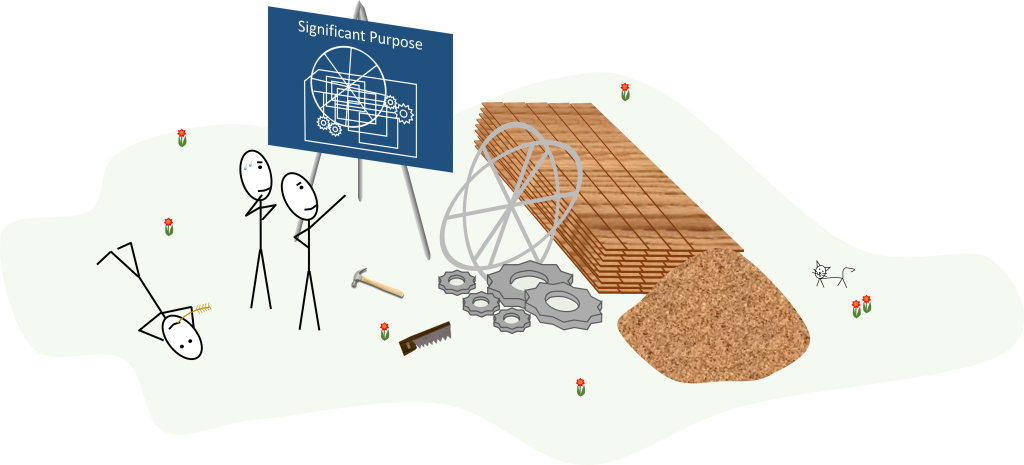
Now that we understand what the missing ingredient is (See Part 1), how can you replicate it in your organisation?
Creating a significant purpose is a creative, reflective and highly iterative process. Creative, in the sense that there is no correct answer and that we only get closer to a correct answer by exploring several possibilities. Reflective, in the sense that the process forces you to dig deep in your organisations dreams and desires. And iterative, in the sense that we recommend not aiming to get it perfect the first time. Rather, derive a first draft, try it out for some time, then adjust it somewhere down the road.
There are three deliverables from creating a significant purpose:
- The significant purpose narrative – a few sentences containing all the meaning of your significant purpose
- The significant purpose statement – a catchy one-line distillate of the significant purpose narrative. This is the statement you can picture yourself yelling out as you rally your troops on the battlefield (or on a company event)
- The significant purpose measures – a set of concrete and measurable features of the future state. These are the features your organisation will evaluate to understand whether or not you have achieved your significant purpose
We begin by defining the significant purpose narrative. To do this, we first make sure to involve the right people.
1. Gather your team
The significant purpose should reflect the collective desires and dreams of your organisation. Your organisation is the collection of the people connected to your organisation, working towards the common purpose. To be able to understand and define the collective desires and dreams of all those people, it’s vital to do some serious involvement. If your organisation is a fresh start-up, include all employees. If your organisation is a large corporation, make sure to gather a diverse group of people from all parts of the organisation, across hierarchy. A perfect team member is a highly respected role model, sharing the values of the organisation. The perfect team size is between 6-12 team members.
2. Challenge your team to write a letter about the purpose of the organisation
A great significant purpose is written in a simple, vivid and evocative language. In other words, it should be formulated in the same manner as you would formulate a letter written to a close family member, recounting an exciting experience you had. It should include visual words and honest feelings.
The best way to ensure simple and evocative language is to challenge your team to imagine that they are writing a letter to one of their parents, explaining the purpose of the organisation. What would they write?
The letter should answer the following questions:
- What are our dreams about the future? In other words, who do we want to impact and what do we want to do for them?
- What is wrong about the world today and what are the root causes?
- Why is our purpose important?
- How will our organisation contribute to making our dreams come true?
An helpful analogy to use when explaining this task, to give some additional meaning to the questions above, is to translate the questions into something everyone is familiar with and understands. It is convenient to use the analogy of the hero’s journey [2].
The hero’s journey
Think of any fantasy book or movie you have seen. It usually follows the same pattern. You first get to know the unlikely hero, for instance some peasant living in a small village. Life goes on as normal, but suddenly something bad happens. A dragon, the villain of this story, steals his wife or some of his kids. The peasant have no choice but to take on the fight with the dragon. The only minor detail is, how is this peasant going to be able to kill the dragon and rescue his family members? Enter the mentor. The mentor is often an old bearded man that has lots of experience. He teaches the peasant all the tricks in the book, and he gives the hero a secret weapon. This is the mentors gift.
Having been equipped, the peasant begins his crusade against the dragon. He first encounters some minor difficulties, but as he approaches the den of the dragon, the level of difficulties increases and culminates in a battle of life and death. As the battles seems to be lost for the peasant, he remembers the mentors gift, the secret weapon. As he uses the secret weapon, the tide of the battle shifts in favour of our peasant. The battle is ultimately won by our peasant, which manages to rescue his family members. As the peasant returns to his village he is greeted as the hero he is. He has liberated the village from the tyranny of the evil dragon. This is the hero’s gift to society.
The customer of the organisation is the unlikely hero. The organisation is the mentor. The organisation enables the hero, the customer, to create the desired future state by equipping the hero with the mentors gift. The hero, the customer, then goes on creating the future state, as a gift to society.
Using this analogy, the questions above can be translated into the following:
- What are our dreams about the future? ==> Who is the hero (the customer) and what do you want the hero to achieve?
- What is wrong about the world today and what are the root causes? ==> Who is the villain?
- Why is your purpose important? ==> What is the hero’s gift to society?
- How will our organisation contribute to making our dreams come true? ==> What is the mentor’s gift to the hero?
For instance, SpaceX enables its customers to make the human race multi-planetary (hero’s gift to society). The villain may be seen as the collection of threats to life on earth (global warming, nuclear weapons, large meteor crashing into earth, …the list goes on). The hero is the different organisations or individuals dreaming of colonizing Mars or doing business in space. The mentors gift is cheap space travel, enabling the hero to achieve his dreams.
Another example is Tesla Motors. Tesla Motors enables its customer to contribute in creating a green, petroleum-free society (hero’s gift to society). The villain is our society’s current dependence on oil and the large corporations championing the status quo. The hero is the customer needing to get from A to B by car, but wanting to do so in an environmentally friendly way. Tesla provides the customer with a car this is not only green, it is also easy for the customer to buy, since it is one of the best cars available on the market (Model S was named the best overall vehicle by Consumer Reports both in 2014 and in 2015).
The mentor’s gift
When deciding on the mentor’s gift, do think holistically. Think about what you want to do for the hero, but also what secondary effects your organisation want to cause, or refrain from causing. Examples are effects on the environment, effects on employees and how much materials you use in your production. Thinking holistically ensures that the significant purpose is complete and sound. For instance, the value of Tesla’s purpose will deteriorate if their production process made their employees sick and demotivated, spent a lot of scarce resources and polluted the local environment around their factories.
3. Identify the core elements and create a first draft of narrative
Having finished up all the letters, you gather your team for a meeting. The purpose of the meeting is to do some good old gold digging. The meeting will be spent searching for those golden nuggets, those core themes and terms, that ultimately will be part of the significant purpose narrative.
As most gold diggers are aware of, some golden nuggets are easy to find, because they just lay there on the ground. The rest of the golden nuggets are harder to find though, hiding deep under the ground, below meters of dirt. Fortunately, we can use the golden nuggets laying above ground as pointers to where the rest of the golden nuggets are hiding.
We start the meeting with identifying the simple golden nuggets. These are the core themes and terms that are explicitly present in the letters from the team members. The best way to separate the golden nuggets from regular rocks is to first ask each member of the team to read out loud his or her letter, and ask everyone else to listen carefully and write down what parts of the letters that deeply connects with them. After each performance, conduct a quick round around the table to write down all the terms and themes on the whiteboard.
Performing this session at SpaceX could have resulted in a whiteboard looking something like this:
Next, we start looking for the hidden nuggets. For this we need to expand the logic, using the simple question “why”.
We first identify the themes and terms that best describes the change your organisation want to see in the world and how your organisation will contribute to this change. This will be the starting point of our logic. Place the terms in a logical order based on cause and effect.
Then we continue exploring the logic by asking “why”, ultimately ending up with questions that we only can answer by turning to philosophy.
When we reach philosophy, we can stop asking “why” and turn to evaluating the logic. Does the logic make sense? Have we skipped any important steps? Are there more hidden golden nuggets?
In the end of the meeting you are left with a list of key themes and terms, of which some of the terms are connected to each other through the logic flow. Based on the list of terms and themes we will now 1) select the terms and themes we wish to include in the significant purpose narrative and 2) create a first draft of the significant purpose narrative. Before concluding the meeting, select a volunteer to do exactly that. The significant purpose narrative will follow the same form and format as the letters, except the “Dear Mum” and “best regards” parts.
4. Evaluate and improve the significant purpose

Having created the first draft of the significant purpose narrative, gather your team for a second meeting. This time, the goal of the meeting is to evaluate the draft according to what constitutes a great significant purpose. Recall the following guidelines:
- It describes a massively desirable and realistic future state in a vivid and evocative language
- It is simple. It describes the massively desirable future in broad strokes
- It connects the desirable future state to the current mind-set or the current wrong way of doing things
- It describes the organisations role in creating the future state
Conduct the meeting as an open discussion and adjust the narrative as you discuss. Before you conclude the meeting, find a volunteer to make a final version of the significant purpose narrative; at least for this iteration.
To give you an example of how a significant purpose narrative may look like, we have applied the method above to our favourite example, SpaceX, loosely based on “The case for Mars”-video [4] and the whiteboard example above:
“The evolution of life has been extraordinary. The major steps being the advent of single-celled life, the differentiation to plants and animals, life going from ocean to land and the introduction of mammals and consciousness.
We wish to see life taking the next important evolutionary step, becoming multi-planetary. We urge for humans to be present in all corners of our solar system, instead of being confined to a single rock. We will not put all our eggs in one basket, just to see them all cracked at some point.
Our mission is to revolutionize space technology to provide cheap and sustainable space travel, enabling humans to live on other planets.”.
5. Create significant purpose statement
Good job! You have now managed to put your organisation’s dreams and desires into writing. The significant purpose narrative has probably become a few sentences in length, to be able to capture all the necessary meaning. The narrative will be the perfect tool to use when you tell a person about your organisation’s significant purpose for the first time. But it is too long to use as a slogan on a company event. Imagine yourself standing on the battle field, rallying your troops and building up the spirit needed to crush the enemy army. In that situation you don’t want to be reading up an entire paragraph. You want to be shouting a short catchy one-liner that everybody immediately recognizes and associates a lot of meaning with. This one-liner is what we call the significant purpose statement.
The significant purpose statement should represent the meaning of the significant purpose narrative in one short, simple and catchy sentence. Hearing the significant purpose statement should revoke the emotions and remind your employees of the dreams they have connected to the significant purpose. In this way, the significant purpose statement works as a shortcut to the meaning in the significant purpose narrative.
To define the significant purpose statement we invite the team to a third meeting. The goal of the meeting is to brainstorm, prioritise and select the significant purpose statement.
Prior to the meeting, challenge the team to do the following reflections:
- Visualise that you’re standing on the podium of a big company event. People are excited because you are going to present the new significant purpose statement. What sentence would make the crowd go wild and feel massively proud and inspired about?
- Write down one to three suggestions for significant purpose statement
Begin the meeting with everyone presenting their suggestions, while the rest privately evaluates how much they are inspired by the statement. Afterward, discuss your favourite parts of the sentences and try to come up with a final sentence together. If you’re not able to finalise this exercise in the meeting, get a volunteer to prepare a few sentences based on the elements people felt the most passionate about and make a quick vote. Voila! You have now defined your significant purpose statement.
6. Define measures
The significant purpose narrative and statement now describes your organisation’s collective dreams and desires. To make the narrative and statement inspiring and easy to visualise you have focused on using simple and evocative language. For the same reason, you have refrained from using any analytical language. But without any specific analytical language describing the significant purpose, how can we down the road know whether or not we have achieved the significant purpose? For instance, when can SpaceX say that we as a human race have become multi-planetary? How many people have to live on Mars before we can say that we have sustainably colonized it?
We need to concretize the significant purpose into a few measures enabling us to check of whether or not we have achieved the significant purpose or are getting closer to the desired future state.
To nail down the measures, we gather the team for a fourth and last meeting. Prior to the meeting we ask everyone to reflect on the following question:
- Visualise the desired future state, what measurable features best describes this future state? Write down two to three suggestions
Spend the meeting gathering the inputs and decide on one to five measures.
One of SpaceX’s measures on whether or not they have achieved making the human race multi-planetary is whether or not there are living one million humans on Mars. This is the critical mass SpaceX deems as a sustainable settlement and hence what it takes to say that the human race is multi planetary.
Congratulations, you have now defined your significant purpose. And not only that, you have defined it in a way tailored for great communication.
The process of creating the significant purpose will have positive impact in itself, at least for those of your employees that have been involved in the process. But the biggest impact is still ahead. The biggest impact comes from communicating the significant purpose to all current and future employees, partners, customers and community and living the significant purpose day in and day out. This will be the topic of Part 3.
Read on or go back to top.
The Missing Ingredient Elon Musk Discovered – Part III – How to Communicate and Live the Significant Purpose
Published 09.07.2016 by Jostein Øysæd (Author) and Bjarte A. Bakke (Editor-in-Chief)
Creating a great Significant Purpose is just the beginning (see Part 1 and Part 2). Now you need to make sure everyone in your organisations lives it.
So far, just a small group of your employees knows your significant purpose, that is, those employees that have been involved in the process. Since they have been involved in shaping it, these employees will likely feel a strong connection and ownership to the significant purpose. As a result, they experience the motivational effects mentioned earlier in this post.
This is a good start, of course, but the goal is obviously to get everyone in the organisation to experience these motivational effects. Not only that, the goal is to let the entire world know about your significant purpose, to attract talent, resources and a supporting community. Thus, some serious communication is required.
It’s also crucial to understand that this communication job is not a one-time communication campaign. The organisation has to be constantly reminded about the significant purpose and use it when making decision in their day to day work.
First things first, let’s begin by communicating the significant purpose, both internally and externally.
1. Communicate the significant purpose

The classic way of communicating a newly defined significant purpose is to include it in a news post on the intranet or send it out to everyone through e-mail, clap yourself on the shoulder and say “there, I communicated it”. Congratulations, you have engaged exactly zero people, since nobody will bother reading it. To engage your employees you need to up the game.
Our goal is for our employees and the rest of the world to experience the significant purpose. That means communicating the significant purpose through as many senses as possible.
A good choice is to use visual aids, such as posters and movies. SpaceX has done just that, creating vintage travel posters for Mars and creating videos explaining the reason behind SpaceX’s purpose of making the human race multi-planetary.
Having created such visual aids, SpaceX makes sure to push them out through all possible communication channels, both traditional media and social media.
An even better choice, most suitable for communication to your employees, is to let your employees experience the significant purpose in real life. For instance, if your organisation produces medical aids, bring your employees to visit some of the users. Let your employees interact with the users and experience how the results they produce is improving the lives of others.
By communicating the significant purpose you have made the ideas available for your employees and the world. Now you need them to connect with the ideas. You need your employees to make the significant purpose their own.
2. Connect your employees with the purpose
The massive motivational effects from a significant purpose will not arise before each and every one of the employees realise that their own personal dreams and desires match with the significant purpose of the organisation. They need to realise that everything they do for the organisation, brings their dreams closer to reality.
This requires that the employees understands their own dreams and desires, and evaluates them against the significant purpose of the organisation.
Here are some useful question you can ask your employees to reflect upon, to understand their dreams and desires:
- In what life situations do you feel most delighted and inspired? Why do you feel most delighted and inspired in these situations?
- Who do you look up to? What is it with these personalities that you like?
- Visualise yourself laying in the coffin in your own funeral. Representatives from your family friends and colleagues walk up to the pulpit, talking about what they liked best about you and what things they admired about you. What would you like them to say? Why would you like them to say these things?
The answer to these questions will give some hints to what your dreams and desires are. In light of the answers, ask the following questions to reflect upon the match between your employees personal dreams and desires and the organisations dreams and desires:
- Do you feel achieving the organisation’s significant purpose is one of the most important things in your life?
- How important is our purpose for you versus everything else you could do with your life?
- Do you feel inspired about the organisation’s purpose every day?
Asking such questions forces your employees to reflect on the significant purpose and hopefully connect with it, realising that there is a large overlap between their own dreams and desires and the significant purpose of the organisation. If there is a connection, there will be motivational effects.
If this reflection exercise uncovers that a significant share of your employees do not feel any connection with the significant purpose, you have to consider the following:
- Change the significant purpose –maybe the team you chose to define the significant purpose was not a representative group of your employees?
- Change the communication of the significant purpose – are you communicating the significant purpose clearly and in an inspiring way?
- Consider changing your staffing – replace those with low connection to your significant purpose with people that connect deeply with it
3. Hire to fit the significant purpose
In a standard hiring process you look at the CV, the grades, the diplomas or certificates and the experience of the candidate. If you are somewhat advanced, you will also assess whether or not the candidate will fit the culture by conducting a psychological evaluation, and whether or not the candidate have the wits required, through case interviews. These are all important elements to assess when evaluating a candidate. But, they are far from the most important element to assess.
Personal fit with the significant purpose is the most important hiring criteria. As we have seen, given enough motivation, a lot of the other things will eventually fall into place. Remember, one Jeff equals at least five Peters, but has the same cost.
When interviewing a candidate, ask similar questions that you asked your employees. Only hire the candidate if the candidate seems to be highly motivated by the purpose.
4. Create constant reminders of the significant purpose
You only get the motivational effects you’re aiming for when your employees keep the significant purpose in their mind, reinforcing the feeling of overlap between significant purpose and their personal dreams and desires. Therefore you have to make sure that you equip your employees sensory environment with constant reminders of you organisation’s significant purpose. Here are some examples of how this can be done:
- Create some large posters on the wall in the office illustrating the significant purpose. In the SpaceX headquarter in Hawthorn, on the wall leading up to Elon Musk’s cubicle, there are two large posters of mars. The one on the left is Mars as it is today—a cold, barren red orb. The poster on the right shows a Mars with a cheery green landmass surrounded by oceans. The planet has been heated up and transformed to suit humans [3]
- Name your conference rooms after your organisations heroes or after terms related to your significant purpose. Again, SpaceX has done exactly this. Most of the conference rooms at SpaceX are named after places on Mars, places in the solar system or famous people in the space industry. For example, Buzz Aldrin, Johannes Kepler, Robert Goddard, etc. [4]
- Place artefacts around in your office building reminding people about the significant purpose. For instance, the US Marine Corps has its Eagle, Globe and Anchor insignia placed around in their bases, symbolising the Corps’ readiness to service in any part of the globe.
- Define and use sayings, mantras and mottos. For instance, Tim Peak’s mission to the International Space Station (ISS) got the name Principia from the European Space Agency (ESA). Since Tim Peak’s main mission was to perform scientific experiments at the space station and to educate and inspire youngsters, it made sense to connect the mission to Isaac Newton’s ground-breaking text on physics. In this context, Principia represents the scientific approach and the scientific mind-set. During the mission, the hashtag #principia has become popular on social media and functions as a constant reminder for the mission crew and community about the purpose of the mission.
5. Incorporate the significant purpose in the decision process
As mentioned, the significant purpose should function as a compass in your organisations decision process. This simply means that you need role models among your leadership, constantly going back to your purpose, saying: “Hi, guys! Are we doing what’s best for our purpose now? Will this decision move our organisation towards achieving our purpose or away from it? Are there any alternatives that will achieve our purpose faster or better?”
Incorporating the significant purpose as part of the decision process, will also work as a constant reminder of the purpose, and will prove that your organisation didn’t just define the purpose as a marketing message. It will prove that the significant purpose is an integral part of the organisation.
Afterthought
By defining, communicating and living the significant purpose according to the steps above, your organisation will be destined for greatness. Imagine your organisation filled up with massively motivated employees, such as Jeff, eagerly devoting a large part of their life working for your organisation, fuelled by the idea of improving the world in some meaningful way.
Now, take this even further. Imagine what the world would be like if the majority of organisations invested time and resources in becoming highly purpose driven, such as SpaceX. Most of us would then be able to find organisation that fitted our dreams and desires. This again would release a massive amount of human performance, thanks to higher motivation, and accelerate the human progress. The short-term-ism seen in today’s profit optimising organisations, would also be long gone. Organisations would focus on optimising their significant purpose instead of optimising for profit. These ideas are what motivated the research and writing of this blog post.
Hopefully, this blogpost has inspired you to start working with your organisation’s significant purpose. As an individual, I hope you invest some time in understanding your own dreams and desires. I hope that you, by appreciating the big impact on motivation you get from working for an organisation sharing your dreams and desires, re-evaluate your career path according to this knowledge. Why not join a purpose driven organisation or start your own?
Please let me know what you think about the blog post, the topic in itself and any experiences related to the topic.
References
[1] Understanding Organizations. Book by Charles Handy, 1993
[2] Winning the Story Wars: Why Those Who Tell (and Live) the Best Stories Will Rule the Future. Book by Jonah Sachs, 2012
[3] Elon Musk: Tesla, SpaceX, and the Quest for a Fantastic Future. Book by Ashlee Vance, 2015
[4] Quora: What are the names of SpaceX’s conference Rooms: https://www.quora.com/What-are-the-names-of-SpaceXs-conference-rooms
Go back to the top.


